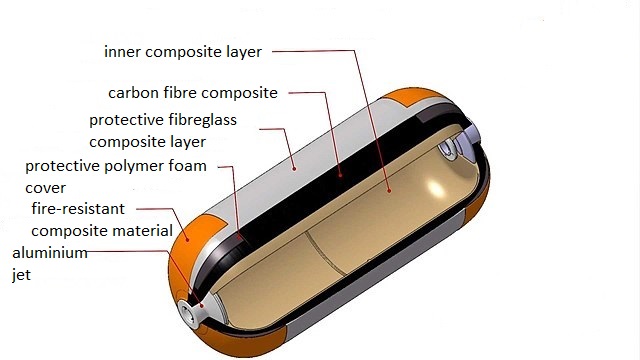COMPRESSED GAS STORAGE
Storing hydrogen as a compressed gas is less energetically demanding compared to storing it in its liquidated form. Vessels for stationary hydrogen storage are made of low-carbon or chrome steel alloy without a weld. The pressure in these tanks is around 200 bar. In the Czech Republic, 61 kg and 50 l volume vessels are mostly common. Cylinders of 1 l or 2 l volume are used for high purity hydrogen. To increase the capacity, small containers are grouped and joined. There are usually ten cylinders in the bunch. Composite cylinders are used for hydrogen transportation. These are made in 10 l to 300l volumes and are coated with a thin layer of metal or special polymer. This layer prevents leakage. The pressure in the cylinders is between 350 – 700 bar, and the technological limit of these containers is 1000 bar. In the case of large volume applications, it is more suitable to use fuel cell vehicles. The fuel cell vehicles are equipped with numerous 50 l volume cylinders or nine horizontal pressure tanks. The gas is then transferred to stationary pressure tanks when delivered to the customer. The stationary pressure tanks are standardised cylindrical vessels operated under 50 bar pressure. They are manufactured in 25, 50 and 90 m3 volumes.

Another method is underground storage. For such method, cavities in salt mines and empty gas deposits are used. This way hydrogen can be stored at pressures up to 110 bar. Higher pressures can exceed the capillary force that is keeping water in micropores and result in hydrogen leakage.
Hydrogen in its gaseous form can be stored in hollow glass microspheres (HGM). This method is still under development. It should be a safe form of hydrogen storage for mobile applications. The HGM are filled with hydrogen under the 350-700 bar pressure and 300°C using diffusion. The gas is then trapped when cooling down to room temperature. To release the gas, HGM needs to be heated to 200 - 300°C. [1]
[1] RIIS, Trygve, Gary SANDROCK, Oystein ULLEBERG a Preben J. S. VIE. Hydrogen
Storage: Gaps and Priorities. [online]. Available at: http://ieahia.org/pdfs/HIA_Storage_G&P_Final_with_ Rev.pdf